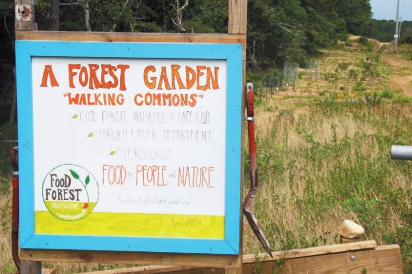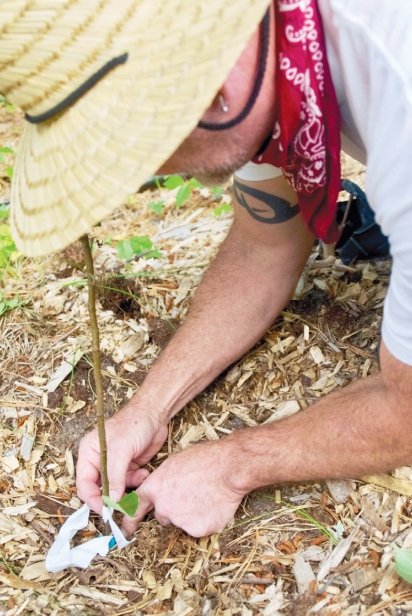Core Essentials: The Art of Grafting
Picture yourself crossing the Atlantic 400 years ago to check out the New World. You step onto that shiny Plymouth rock and stumble onto solid ground, rejoicing to have made it. Still able to feel the roll and pitch of the waves, you wobble as you join some fellow travelers headed north to explore the area we now call Boston. Several days later the gang shares the last snacks left from the voyage: a dozen small, misshapen, yet still crunchy apples.
Munching furiously and nearly swallowing the seeds, you toss the core onto ground now known as Roxbury. Landing in a roadside ditch, weeks pass until several of the seeds sprout. Ten years in and one of the hardiest of the saplings remains, its branches covered in fruit. Considered widely to be the first domestic apple tree grown in North America, in 1645 it’s dubbed the Roxbury Russet.
The common apple, Malus domestica, is now one of our most popular fruits, yet it certainly didn’t start out that way. The only apple native to North America is, in fact, the crabapple. Numerous apple varieties arrived here just like the colonists did — by boat; they were brought along most often in the form of fruit, occasionally as seeds slipped into clothing hems and satchels, and only rarely as actual young trees packed away on the ships.
Where did the colonists source their apples? DNA tests show that apples were domesticated 4000-10,000 years ago from wild apples in the Tian Shan Mountains of Kazakhstan, the ninth largest country in the world, located in Central Asia. From there the apples travelled the globe via the Silk Road trade route, eventually reaching Europe. The importance of these apples being brought across the ocean by the colonists cannot be underscored enough. Brought along not only for passenger food and livestock fodder, they were an essential tool in the fight against the infectious disease cholera, which was rampant at the time and that is carried in the water supply. Fruit, most often apples, kept people and their farm animals hydrated. The common beverages of the day, including children, were weak cider, beer, or fermented tea (think kombucha) for all to get their much-needed rations of safe drinking water.
“I love history,” says Tom Fettig, “and so when learning of this, I was hooked.” Fettig’s passion for growing apples and eventually, grafting them, was launched in 2007, when his sister, Mary Fettig, gave him the book Gaia’s Garden by Toby Hemenway, an introduction to permaculture for the home gardener. “I read it, and that was it,” he says. “It changed my life.”
Over the next six years he continued to learn about these ideas, enrolling in an extensive permaculture design program in Vermont. “One course on tree grafting really spoke to me,” says Fettig. “I’m a history kind of guy.” This focus would inspire in him a passion for preserving heirloom apple varieties.
The skill of grafting, although it’s not known exactly when it began, has been practiced by cultures worldwide for centuries. Basically, it is the placement of a piece of live plant tissue (the graft) onto another growing plant (the rootstock). In a successful graft, everything above the joining point will have the characteristics of the new tissue, while the rootstock’s qualities remain unchanged. Grafting is especially important for plants like apples whose seeds do not breed true to the parent; it is how we are able to replicate desired varieties and keep them in existence. Plus, multiple grafts can be applied to one rootstock, resulting in more than one type of apple (or cultivar) on a single tree; an example being an espaliered apple tree that might have with up to six different types of apples growing at once.
Many techniques and personal variations are used to create the actual grafts, including different patterns and cut sizes made into the rootstock. The way the new plant material is inserted or attached can also vary. The added new plant tissue is either in the form of scion wood (a shoot or twig) or a live bud from last year’s tree growth. The area of joining is commonly held together by a layer of paraffin or wrapped with paraffin tape, to keep the insertion site moist and somewhat pliable. Splints (popsicle sticks work) can fortify the area from birds or wind damage until healed. Fettig advises that keeping knives sharp can help prevent slipping and potential injuries. Disinfecting the cutting blade with alcohol prevents fungus or bacteria from being introduced at the point of incision. The joining site never forms actual bark but scars permanently when healed.
Scion wood is genetically identical to varieties that may be hundreds of years old. Ideally these cuttings of twigs or small branches are harvested between December and late January, when plant cells are in dormancy. Grafting aficionados can now purchase specimens from all over the world online, storing them in the fridge until spring when grafting is done most successfully. “You do need to consider the climate where you live,” says Fettig, “since some apples require a very cold winter to thrive. Others, like the Winesap, which excels in Virginia, tends to suffer here on Cape Cod.” While focused on keeping local New England varieties alive, occasionally he ventures farther afield, “It’s hard to resist some of the intriguing names like the Pitmaston Pine apple, originating in England.”
Keeping apple trees of any variety healthy after you’ve planted them is no easy feat anywhere when you consider the range of possible diseases and pests. “Cedar apple rust, apple scab, and just about every fungal disease known to man, are all active here,” says Fettig. “They really propagate during our wet and soggy springs. Some of this disease and pest pressure can be minimized using organic methods, including neem oil, Bacillus thuringiensis and even a fine misting of kaolin, which leaves an innocuous film of white clay preventing fungal spores. It’s a real challenge.”
Fettig sometimes discovers old apple trees like the Roxbury Russet he found thriving nonchalantly on a main thoroughfare in his hometown. This variety stores beautifully, is disease and pest resistant, and with a 12 percent sugar content, would make a fantastic hard cider. Hopeful that the property owner will permit him to harvest some cuttings this winter, Fettig says, “Heritage varieties like this that have persevered through the centuries, are the specific trees we should be collecting scion wood from, and for precisely that reason.”
Besides being important for bolstering the population of particularly disease resistant trees, grafting is a lifeline for rare species in danger of extinction. Similar to saving seeds, if you can obtain 6-10 inches of a live wood sample, you have the opportunity to apply a graft to an existing rootstock to possibly continue that lineage. “I’m a student of history and these obscure varieties give you a real glimpse of the past,” says Fettig. “Once their genetics are gone, we can’t recreate them.”
Commercially, grafting provides the vehicle for novel apples that are developed in breeding programs, like the recently added Jazz, to be brought to market quickly, as the new variety can be grafted onto already mature rootstock, saving valuable time and expense. Others, like the Ambrosia apple, appear like the Granny Smith apple did decades ago, totally by chance in nature, as a seedling in someone’s field, but then these newly discovered varieties can also be replicated by grafting. China and Japan lead amongst nations developing new cultivars, but it’s not always for flavor. Fettig says, “New varieties are bred to satisfy the needs for distance shipping and long storage times or are being genetically modified so that their exposed flesh will resist turning brown.”
By mixing and matching rootstocks and grafts, even the novice grafter can effectively design a tree for qualities they want to enhance or suppress. “Some apple trees naturally top thirty feet in height,” says Fettig. “I’d rather avoid the ladder and so I choose semi-dwarf varieties to graft onto, so I can reach the fruit.” Recently, Brent Hemeon, owner of Hemeon Farm in Harwich Port, shared scion wood cuttings with Fettig from some of his “babies,” including Old English, French, New England and Massachusetts apples, plus a sample of the Haroldsen, an old Maine variety. Hemeon, who remembers playing as a young boy among these trees, continues to raise apples, other fruits and produce on the same land his grandfather farmed over 100 years ago. “It’s nice to be able to preserve some of these local varieties for future generations,” says Fettig.
Fettig enjoys educating and sharing his knowledge as he experiments with grafting and acquiring more permaculture skills. He understands how permaculture design principles and installation concepts can transform our typical American yards, helping to capture and direct water, and provide permanent food plantings. He’s done some tree consults Cape wide, and grafts at The Lighthouse Charter School garden. Presently his family is involved in The Food Forest Initiative’s experimental joint venture with Eversource and the town of Harwich Water Department. These volunteers pledged to keep a swath of land, located on Bay Road under the power lines, clear of brush. In exchange, the power company will refrain from spraying Roundup, the herbicide, on this area. Not for the “faint of forest,” these stalwarts weed whack, manually clear brush, and battle poison ivy and abundant ticks. The group is making valiant efforts, employing permaculture principles like creating contour berms (raised areas to promote moisture retention on slopes) and planting low maintenance edible perennials and pollinator wildflowers. Their enthusiasm and work ethic have persevered, resulting in multiple planting and gorilla maintenance Meetups. To date, they have created an initial food forest which includes hazelnut trees, aronia shrubs, low bush blueberries, and other plants. Fettig has also planted a number of rootstocks, onto some of which he’s already applied grafts.
“At one time,” says Fettig, “grafting was an essential skill like milking a cow; it was very common knowledge.” Today, grafting is not entirely an unheard-of pastime. However, compared to growing zucchini, or even planting apple trees, it’s a pretty exclusive club. It may be a good thing that it be reserved only for those compelled to attempt it. Fettig recalls the time he finally agreed to do a hands-on grafting workshop locally. “Despite every caution, the first participant [his daughter Alexandra] cut herself. Immediately followed by a second piercing right through her down jacket,” he shares, with a wincing grin.
While Fettig didn’t get bit by the grafting bug until adulthood, it has quickly grown dear to his heart; it’s an art he enjoys sharing with his community, friends and family — especially with Fettig’s wife, Kristin Knowles, a direct descendent of the Mayflower settlers. Talk about keeping your family tree alive.
To reach Tom Fettig:
774-801-8435
SaltHayHomeServices.com
For more information on permaculture and grafting, Fettig recommends:
Books:
The Apple Grower: Guide for the Organic Orchardist
by Michael Phillips
Gaia’s Garden: A Guide to Home-Scale Permaculture
by Toby Hemenway
The Resilient Farm and Homestead: An Innovative Permaculture and Whole Systems Design Approach
by Ben Falk
University agriculture programs, such as those at Cornell, Purdue, Minnesota and Mississippi.
YouTube videos by Stephan Hayes, heritage apple grower in England.








